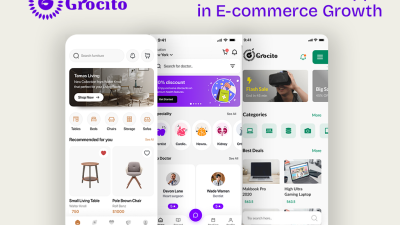The e-commerce landscape is ever-evolving, driven by technological advancements, changing consumer behaviors, and global market dynamics. As we look ahead to the future, several trends and innovations are poised to shape the e-commerce industry. Staying informed and prepared for these changes is crucial for businesses aiming to remain competitive and thrive. In this blog, we’ll explore key predictions for the future of e-commerce and how businesses can prepare to capitalize on these opportunities. Let’s see The The Future of E-commerce Predictions and Preparations.

1. Continued Growth of Mobile Commerce
Mobile commerce, or m-commerce, is expected to continue its rapid growth. With more consumers relying on smartphones for shopping, businesses must prioritize mobile optimization. This includes ensuring responsive design, fast loading times, and a seamless checkout process. Investing in a dedicated mobile app can further enhance the shopping experience and drive customer engagement.
Preparation Tips:
- Optimize your website for mobile devices.
- Develop a user-friendly mobile app.
- Implement mobile payment options like digital wallets and UPI.
2. Rise of Augmented Reality (AR) and Virtual Reality (VR)

AR and VR technologies are set to revolutionize the online shopping experience. These technologies allow customers to visualize products in their environment or try them on virtually before making a purchase. This immersive experience can reduce uncertainty and increase customer confidence, leading to higher conversion rates.
Preparation Tips:
- Explore AR and VR solutions for your product offerings.
- Integrate AR features into your mobile app or website.
- Provide virtual try-on options for products like clothing and accessories.

3. Increased Focus on Sustainability
Sustainability is becoming a significant factor in consumer purchasing decisions. Shoppers are increasingly looking for eco-friendly products and brands that prioritize sustainable practices. Businesses that adopt sustainable practices and transparently communicate their efforts can attract environmentally conscious customers and build long-term loyalty.
Preparation Tips:
- Implement sustainable sourcing and production practices.
- Use eco-friendly packaging materials.
- Highlight your sustainability initiatives on your website and marketing materials.
4. Expansion of Social Commerce
Social media platforms are evolving into powerful e-commerce channels. Social commerce involves selling products directly through social media platforms like Instagram, Facebook, and TikTok. These platforms offer features such as shoppable posts, live shopping events, and in-app checkout, making it easier for consumers to purchase without leaving the app.
Preparation Tips:
- Leverage social media marketing to drive traffic and sales.
- Utilize shoppable posts and in-app checkout features.
- Host live shopping events to engage with your audience.
5. Growth of Subscription Services

Subscription services are gaining popularity as they offer convenience and value to customers. Whether it’s a monthly box of curated products or a subscription for regular deliveries of essentials, this model can drive customer loyalty and recurring revenue. Businesses can benefit from predictable income and stronger customer relationships.
Preparation Tips:
- Develop subscription-based offerings for your products.
- Provide flexible subscription plans to cater to different customer needs.
- Offer exclusive benefits to subscribers, such as discounts and early access to new products.
6. Enhanced Personalization with AI
Artificial intelligence (AI) is transforming the way businesses interact with customers. AI-powered tools can analyze customer data to provide personalized recommendations, dynamic pricing, and targeted marketing. Personalization enhances the shopping experience, increases customer satisfaction, and boosts sales.
Preparation Tips:
- Implement AI-driven personalization tools on your website and app.
- Use customer data to tailor product recommendations and marketing messages.
- Continuously refine your personalization strategies based on customer feedback and behavior.
7. Omnichannel Retailing
Omnichannel retailing provides a seamless shopping experience across multiple channels, including online stores, physical locations, and social media. Consumers expect a consistent experience, whether they’re shopping on your website, mobile app, or in-store. An integrated omnichannel strategy ensures a cohesive customer journey and maximizes sales opportunities.
Preparation Tips:
- Create a unified shopping experience across all channels.
- Ensure consistent branding and messaging across online and offline platforms.
- Use data analytics to track customer interactions and preferences across channels.
8. Emphasis on Data Privacy and Security

With increasing concerns about data privacy, consumers are more cautious about sharing their personal information online. Ensuring robust data security measures and transparent privacy policies can build trust and protect your customers’ data. Compliance with data protection regulations is also essential to avoid legal issues.
Preparation Tips:
- Implement strong data security measures to protect customer information.
- Clearly communicate your privacy policies and data protection practices.
- Stay updated on data protection regulations and ensure compliance.
Conclusion

The future of e-commerce is filled with exciting opportunities and challenges. By staying informed about emerging trends and preparing to adapt, businesses can position themselves for success in the evolving digital landscape. Whether it’s embracing mobile commerce, leveraging AR and VR technologies, or focusing on sustainability, the key is to remain agile and customer-centric. Grocito is here to support your journey with comprehensive e-commerce solutions that help you stay ahead of the curve. Embrace the future of e-commerce and watch your business thrive!





